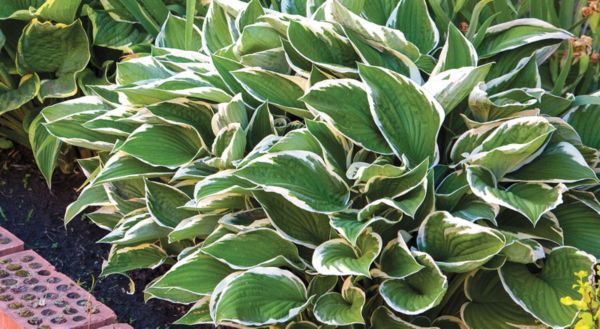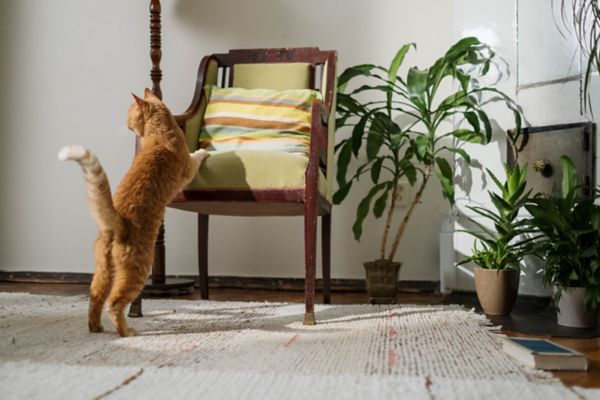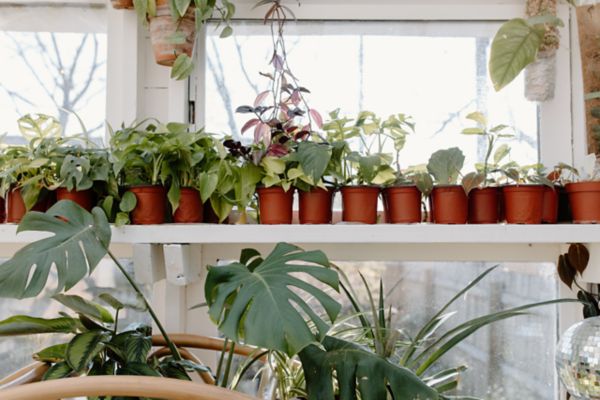How to Grow Pothos
Authored by Leah Chester-Davis
Pothos might very well be the ideal houseplant. It can thrive in a wide range of conditions and even handle neglect, not that you’d do that to your plants. In short, this is a tough, low-maintenance plant that is one of the most popular indoor plants, year after year.
In its native habitat of the Solomon Islands in the Pacific and in warmer climates where it can grow outside year-round, its foliage grows quite large, and its vining habit creates a groundcover that grows 6 to 8 inches tall, or it climbs up trees as high as 40 feet tall.
As an indoor plant, it is commonly grown in hanging baskets to better display its draping vines and heart-shaped leaves, though it looks pretty in any container. If the container is outfitted with totem or pole, pothos will climb and twine around the pole with its adhesive aerial roots, a good choice if you wish to add height or an architectural element to the corner of a room. Because of its vining nature, it can also be the “spiller” in a container with more upright plants. It can be pruned to keep a short, full, bushy plant.
Commonly called pothos, it is sometimes referred to as devil’s ivy, devil’s vine, or golden pothos. It is a member of the Arum family. The glossy or waxy leaves grow to about 3 to 4 inches long. Many pothos plants are typically variegated with green and gold or green and silver though there are cultivars like ‘Neon’ that is a bright green-gold or chartreuse and others that have silvery-blue foliage like ‘Cebu Blue’.
About pothos
| Botanical name: | Epipremnum aureum |
| Common name: | Pothos |
| Plant type: | Annual; indoor plant, except zones 10 to 12 |
| Size: | 6 inches to around 8 feet as houseplant |
| Sun exposure: | Filtered, medium light |
| Soil type: | Well-drained, potting mix |
| Soil pH: | 6 to 6.5 |
| Hardiness zones: | 10 to 12 |
| Average first frost: | Varies by region |
| Average last frost: | Varies by region |
| Container friendly: | Yes |
| Beginner friendly: | Yes |
Growing
Pothos likes medium, filtered light, high humidity and warm temperatures, between 70 to 90 degrees, but will tolerate other conditions, even low light. Keep it out of direct sun.
As with other plants, position pothos so that it is not exposed to air and temperature fluctuations or drafts. Drafts change humidity levels and can dry out foliage.
Like other indoor plants, pothos can be taken outside for rejuvenation after the danger of frost has passed in the spring. Move it to a protected area to give it time to acclimate to the outdoors and bring it back inside before the first frost. Use caution when growing pothos outdoors in zone 10 or warmer. According to Florida Extension, the plant is considered invasive in south Florida and is on the caution list for central Florida, meaning there is moderate risk of ecological and economic damage if it escapes into the wild in frost-free climates.
Like other indoor plants, pothos can be taken outside for rejuvenation after the danger of frost has passed in the spring.
Planting
Plant pothos in a container with drainage holes. Use a quality potting medium, such as a soilless mix, that drains well. Allow it to dry out between waterings. It does better in dry soil than in wet soil. Soggy soil can lead to root rot.
Pothos, or any houseplant, may benefit from repotting on occasion. If roots are growing out the drainage hole, that’s a clue it’s time to repot your plant. Select a container 1 to 2 inches larger than the current container. Make sure it has drainage holes and use a soilless mix. Avoid going larger than a couple of inches because the extra potting mix needed in a larger container can hold more water than your plant can take up, leaving the roots wet for too long.
Allow it to dry out between waterings. It does better in dry soil than in wet soil.
Fertilizing
- Like any houseplant, pothos benefits on occasion from added nutrients. Apply a water-soluble fertilizer for houseplants every other month and follow label directions. If you have just purchased pothos, the potting medium likely contains fertilizer, and the plant may not need an application for 2 or 3 months. Cease fertilization during the winter when the plant growth has slowed.
Controlling Pests, Diseases, and Other Problems
- This plant typically isn’t affected with serious pest problems. Sometimes mealybugs, spider mites, or scales can be a problem. Mealybugs cover themselves with a white, cotton-like substance. Dip a cotton swab in rubbing alcohol and swipe it over the leaves. If mites are a problem, give the plant a good cleaning by holding the foliage under running water. Scales are dark-colored bumps on the stems or leaves. If there are only a few, scrape off with a fingernail or swipe the area with a cotton swab and alcohol. If infestations are heavy and unsightly, prune away the infected area or discard the entire plant.
Variegated plants that are exposed to low lights may lose their variegation and turn a solid green.
Expert Tips
- Older leaves turn yellow and drop off. This plant benefits from an occasional pruning of its stems to help it maintain a fuller appearance. Use sharp scissors and cut anywhere along the stem, just above a node.
- It also benefits when any dust is removed from its leaves. On occasion, simply use a soft, damp cloth and gently wipe the leaves to remove any dust.
- Variegated plants that are exposed to low lights may lose their variegation and turn a solid green.
- The plant is poisonous to humans so keep out of reach of children. Cats and dogs can be sensitive to it.
Frequently asked questions
Is it possible to propagate pothos?
It is quite easy to propagate this plant. Simply take 5- or 6-inch cuttings and stick them into water or vermiculite. After the roots appear, plant the cuttings in a container with a soilless mix. It also can be propagated by root division when repotting. Gently separate the roots into more than one plant. Another way to propagate is by layering the aerial roots that appear at the nodes. To layer, simply push a section that has a node with aerial roots into the soil around the mother plant to start a new plant. The vine will likely stay in place but, if needed, use a piece of wire to secure the aerial root section to the soil.
Why does my plant have blackened leaf tips and margins?
This can be caused by a few different things. First, consider how often you water the plant. Are you overwatering? That could be the culprit. If you know you haven’t overwatered your plant, consider whether you are watering it enough. It may simply be quite thirsty, and those dark tips are a signal that the plant needs a drink. If it doesn’t seem to be a watering problem, it might be due to excess fertilizer. Over time, the salts in fertilizer can build up and cause problems for plants. The best way to address this is by flushing the soil thoroughly by giving the plant lots of water until it is running freely from the bottom of the container. The extra water helps leach out the salt. Another solution would be to repot the container into a fresh potting mix.





